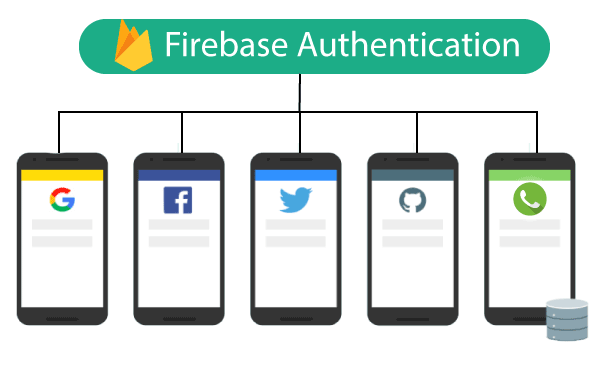Firebase Authentication

In the present era, user authentication is one of the most important requirements for Android apps. It is essential to authenticate users, and it is much harder if we have to write all this code on our own. This is done very easily with the help of Firebase.
- Being able to authenticate our users securely, it offers a customized experience to them based on their interests and preferences.
- We can ensure that they have no problems accessing their private data while using our app from multiple devices.
- Firebase Authentication provides all the server-side stuff for authenticating the user. Firebase Authentication becomes easy with SDK. It makes API easy to use.
- Firebase Authentication also provides some user interface libraries which enable screens for us when we are logging it.
- Firebase authentication supports authentication using a password, phone numbers, popular identity provider like Google, Facebook, and Twitter, etc.
- We can sign in users to our app by using the FirebaseUI.
- It handles the UI flows for signing in user with an email address and password, phone numbers, and popular providers, including Google sign-In and Facebook Login.
- It can also handle cases like account recovery.
- It is not required to design a UI since it is already provided for us. It means we don't have to write the activities.
- We can also sign-in users using the Firebase Authentication SDK to integrate one or several sign-in methods into our app manually.

Firebase UI Authentication Method
Firebase UI Authentication is a way to add a complete sign-in system to our app, where Firebase provides user interface to them. Firebase UI provides a drop-in auth solution which is used to implement authentication on mobile devices and websites.
Firebase UI can be easily customized to fit with the rest of our app's visual style. It is open-source, so we are not constrained in modifying the user experience to meet our apps need.
There are the following steps to use Firebase UI Authentication:
- Set up sign-in methods:
- Enable authentication method in the firebase console.
- For email address and password, phone number sign-in, and any identity providers.
- We have to complete the configuration if anyone requires for identity providers.
- Setting our OAuth redirect URL.
- Customize the sign-in UI.
- For customizing the sign-in and UI, we have to set some Firebase UI options or fork the code on GitHub.
- To perform the sign-in flow, use Firebase UI:
- Import the Firebase UI library.
- Specify the sign-in method which we want to support.
- Initiate the Firebase UI sign-in flow.
Firebase SDK Authentication Method
This is another type of authentication method. The Firebase SDK Authentication provides methods for creating and managing users who use their email addresses and password to sign in. SDK also handles sending password reset emails.
- We can also provide phone number authentication using SDK
- The authentication of users by sending SMS messages to their phones.
- We can authenticate users by integrating with identity providers.
- SDK provides methods which allow users to sign-in with their Google, Facebook, Twitter, and GitHub accounts.
- We can connect our app's existing sign-in system to the Firebase Authentication SDK and gain access to Firebase Real-time database and other Firebase services.
- We can create a temporary anonymous account to use Firebase features, which requires authentication
without requiring users to sign-in first.
There are the following steps to use Firebase SDK Authentication:
- Set up sign-in methods:
- We have to enable the authentication method in the Firebase console for an email address and password or phone number sign-in and any identity providers.
- We have to complete the configuration if anyone is required for identity providers.
- Setting our OAuth redirect URL.
- Implementing UI flows for our sign-in methods:
- For email signing, add screens which prompt the user to type their email addresses
- For phone number sign-in, add screens which prompt users to type their phone number, and after that, for the code from the SMS message they receive.
- For identity sign-in, implement the flow required by each provider.
- Passing the user's credentials to the Firebase Authentication SDK:
- Pass the user's email address and password.
- Pass the OAuth token, which was acquired from the identity provider.
How Authentication Works?
- We first get authentication credentials from the user to sign a user into our app.
- Credentials can be the user's email address and password.
- The credential can be an OAuth token from an identity provider.
- We then pass these credentials to the Firebase Authentication SDK. Backend services will then verify those credentials and return a response to the client.
- After a successful sign in:
- We can access the user's access to data stored in other Firebase products.
- We can access the user's basic profile information.
- We can use the provided authentication token to verify the identity of users in our own backend services.
- An authenticated user can read and write data to the Firebase Real-time Database and Cloud Storage.
- We can control the access of those authenticated users by modifying the Firebase Database Rules and Storage Security Rules.
Users
- A Firebase User object represents the account of a user who has signed up to the app in Firebase project. Apps have many registered users, and every app in a Firebase project shares a user data base.
- AFirebase User instance is independent of a Firebase Auth instance. It means we can have several references to different users within the same context and still call any of their method
- A Firebase User has a fixed set of basic properties such as Unique ID, Primary email address, Name, and a photo URL.
- Firstly, a user signs up to the app. The user's profile data is populated with the primary email address if using email/password auth, account information available by the provider if using identity auth, and anything we want if using custom auth.
- The user becomes the current user of the Auth instance when a user signs up or signs in.
- The Auth instance stops to keep a reference to the User object. And no longer persists it states when a user signs out:
- No current user
- The user instance continues to be completely functional
- If we keep a reference to it, we can still access and update the user's data.
- Using listeners is the recommended way to track the current state of the Auth instance.
- An Auth listener gets notified any time when something relevant happens to the Auth object.
User Lifecycle
- An Auth listener gets notified in the following situation
- The Auth object finishes initializing, and a user was already signed in from a previous session or has been redirected from an identity provider's sign-in flow
- A user signs in.
- A user signs out.
- The current user's access token is refreshed:
- The access token expires.
- The user changes their password.
- The user re-authenticates
|


 For Videos Join Our Youtube Channel: Join Now
For Videos Join Our Youtube Channel: Join Now










